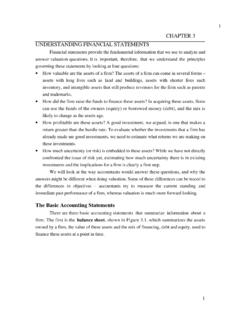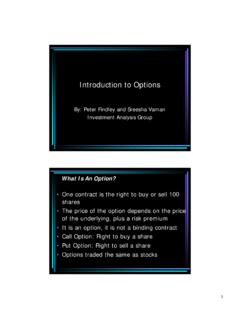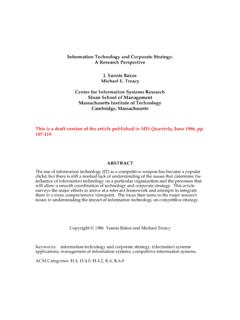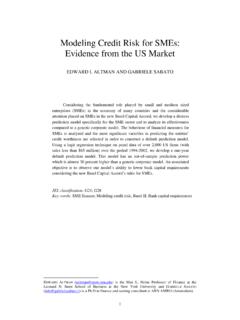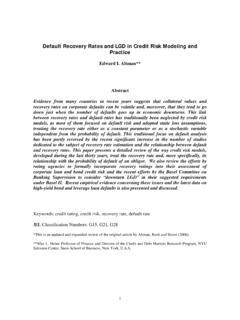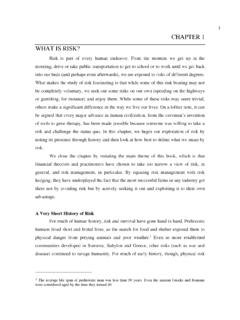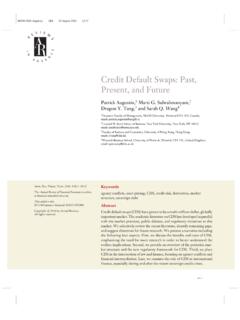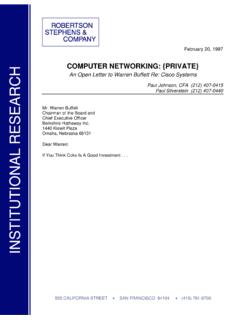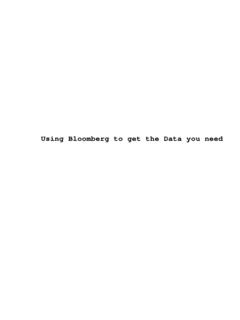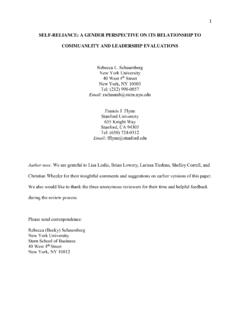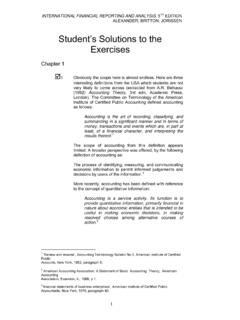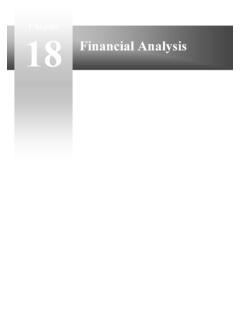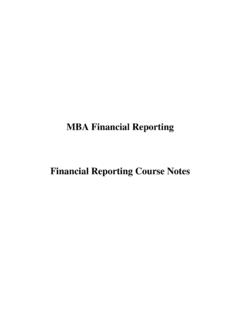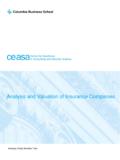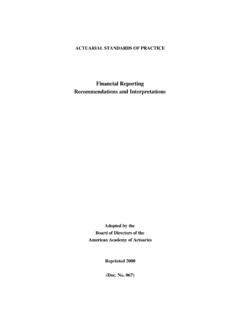Transcription of Financial Statement Analysis - New York University
1 Aswath Damodaran!1! Financial Statement Analysis ! The raw data for investing Aswath Damodaran!2!Questions we would like !AssetsLiabilitiesAssets in PlaceDebtEquityWhat is the value of the debt?How risky is the debt?What is the value of the equity?How risky is the equity?Growth AssetsWhat are the assets in place?How valuable are these assets?How risky are these assets?What are the growth assets?How valuable are these assets?Aswath Damodaran!3!Basic Financial Statements! The balance sheet, which summarizes what a firm owns and owes at a point in time. The income Statement , which reports on how much a firm earned in the period of Analysis The Statement of cash flows, which reports on cash inflows and outflows to the firm during the period of Analysis Aswath Damodaran!
2 4!The Accounting Balance Sheet!AssetsLiabilitiesFixed AssetsDebtEquityShort-term liabilities of the firmIntangible AssetsLong Lived Real AssetsAssets which are not physical,like patents & trademarksCurrent AssetsFinancial InvestmentsInvestments in securities &assets of other firmsShort-lived AssetsEquity investment in firmDebt obligations of firmCurrent LiabiltiesOther LiabilitiesOther long-term obligationsFigure : The Balance SheetAswath Damodaran!5!Principles underlying accounting balance sheets! An Abiding Belief in Book Value as the Best Estimate of Value: Unless a substantial reason is given to do otherwise, accountants view the historical cost as the best estimate of the value of an asset. A Distrust of Market or Estimated Value: The market price of an asset is often viewed as both much too volatile and too easily manipulated to be used as an estimate of value for an asset.
3 This suspicion runs even deeper when values are is estimated for an asset based upon expected future cash flows. A Preference for under estimating value rather than over estimating it: When there is more than one approach to valuing an asset, accounting convention takes the view that the more conservative (lower) estimate of value should be used rather than the less conservative (higher) estimate of value. Aswath Damodaran!6!Measuring asset value! Since accounting statements, at least as structured now, begin with the historical cost at which assets were acquired and financing raised, they are no designed to measure the current value of assets. The only assets that are reported at or close to market value, at most companies today, are current assets.
4 There are a handful of sectors (such as banks) where assets are marked up to market. As a consequence, the liabilities and the shareholders equity from an accounting Statement are not measures of the current values of either. Fair value accounting, a trend in both US and international accounting, aims to bring asset values in accounting balance sheets closer to their current market values. Aswath Damodaran!7!A Financial Balance Sheet!AssetsLiabilitiesAssets in PlaceDebtEquityFixed Claim on cash flowsLittle or No role in managementFixed MaturityTax DeductibleResidual Claim on cash flowsSignificant Role in managementPerpetual LivesGrowth AssetsExisting InvestmentsGenerate cashflows todayIncludes long lived (fixed) and short-lived(working capital) assetsExpected Value that will be created by future investmentsAswath Damodaran!
5 8!The Income Statement !Figure : Income StatementRevenuesGross revenues from sale of products or services- Operating ExpensesExpenses associates withgenerating revenues= Operating IncomeOperating income for theperiod- Financial ExpensesExpenses associated withborrowing and other financing- TaxesTaxes due on taxable income= Net Income before extraordinary itemsEarnings to Common & Preferred Equity forCurrent Period- (+) Extraordinary Losses (Profits)Profits and Losses notassociated with operations- Income Changes Associated with Accounting ChangesProfits or losses associatedwith changes in accountingrules- Preferred DividendsDividends paid to preferredstockholders= Net Income to Common StockholdersAswath Damodaran!9!Principles underlying accounting income statements!
6 Accrual accounting: In accrual accounting, the revenue from selling a good or service is recognized in the period in which the good is sold or the service is performed (in whole or substantially). A corresponding effort is made on the expense side to match expenses to revenues. Expenses are categorized into operating, financing and capital expenses. Operating expenses are expenses that, at least in theory, provide benefits only for the current period; the cost of labor and materials expended to create products that are sold in the current period is a good example. Financing expenses are expenses arising from the non-equity financing used to raise capital for the business; the most common example is interest expenses. Capital expenses are expenses that are expected to generate benefits over multiple periods; for instance, the cost of buying land and buildings is treated as a capital expense.
7 Aswath Damodaran!10!Measuring accounting profitability! Profit relative to investment: By scaling profits to the capital invested in an asset or business, you get accounting returns. It can take these forms: Return on equity = Net Income/ Book Value of Equity Pre-tax Return on (invested) capital = Operating Income/ (Book Value of Equity + Book Value of Debt Cash) Profit, relative to revenues: By scaling profits to revenues, you can arrive at profit margins. Again, it can take two forms: Net Margin = Net Profit/ Revenues Operating Margin = Operating Income/ Revenues Both return on capital and operating margin can also be computed in after-tax terms, by multiplying each by (1- tax rate) Aswath Damodaran!11!Measuring Financial leverage!
8 Debt, relative to equity and capital: The debt due in a business can be scaled to either the equity in the business or the total capital (debt plus equity). Debt/ Equity Ratio = Debt/ Equity Debt/Capital Ratio = Debt/ (Debt + Equity Both ratios can be computed in book value or market value terms. Debt obligations, relative to cash flows and earnings: The Financial leverage burden can also be stated in terms of total debt or debt payments each period: Debt/EBITDA = Debt/ EBITDA Interest coverage ratio = Operating Income/ Interest Expenses Aswath Damodaran!12!Accounting ! There are a few expenses that consistently are miscategorized in Financial particular, Operating leases are considered as operating expenses by accountants but they are really Financial expenses R &D expenses are considered as operating expenses by accountants but they are really capital expenses.)
9 The degree of discretion granted to firms on revenue recognition and extraordinary items is used to manage earnings and provide misleading pictures of profitability. Aswath Damodaran!13!Dealing with Operating Lease Expenses! Debt Value of Operating Leases = PV of Operating Lease Expenses at the pre-tax cost of debt This now creates an asset - the value of which is equal to the debt value of operating leases. This asset now has to be depreciated over time. Finally, the operating earnings has to be adjusted to reflect these changes: Adjusted Operating Earnings = Operating Earnings + Operating Lease Expense - Depreciation on the leased asset If we assume that depreciation = principal payment on the debt value of operating leases, we can use a short cut: Adjusted Operating Earnings = Operating Earnings + Debt value of Operating leases * Cost of debt Aswath Damodaran!
10 14!The Effects of Capitalizing Operating Leases! Debt : will increase, leading to an increase in debt ratios used in the cost of capital and levered beta calculation Operating income: will increase, since operating leases will now be before the imputed interest on the operating lease expense Net income: will be unaffected since it is after both operating and Financial expenses anyway Return on Capital will generally decrease since the increase in operating income will be proportionately lower than the increase in book capital invested Aswath Damodaran!15!R&D Expenses: Operating or Capital Expenses! Accounting standards require us to consider R&D as an operating expense even though it is designed to generate future growth. It is more logical to treat it as capital expenditures.
